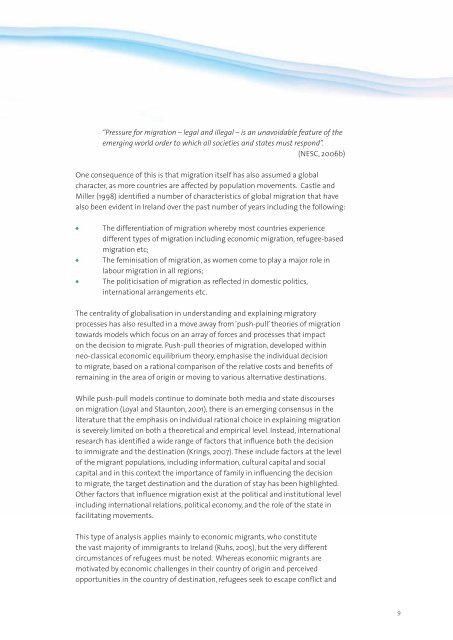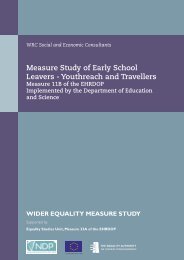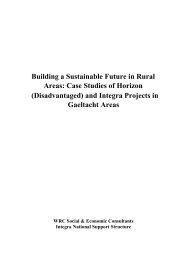Issues and Challenges in the Recruitment and Selection of ...
Issues and Challenges in the Recruitment and Selection of ...
Issues and Challenges in the Recruitment and Selection of ...
Create successful ePaper yourself
Turn your PDF publications into a flip-book with our unique Google optimized e-Paper software.
“Pressure for migration – legal <strong>and</strong> illegal – is an unavoidable feature <strong>of</strong> <strong>the</strong>emerg<strong>in</strong>g world order to which all societies <strong>and</strong> states must respond”.(NESC, 2006b)One consequence <strong>of</strong> this is that migration itself has also assumed a globalcharacter, as more countries are affected by population movements. Castle <strong>and</strong>Miller (1998) identified a number <strong>of</strong> characteristics <strong>of</strong> global migration that havealso been evident <strong>in</strong> Irel<strong>and</strong> over <strong>the</strong> past number <strong>of</strong> years <strong>in</strong>clud<strong>in</strong>g <strong>the</strong> follow<strong>in</strong>g:• The differentiation <strong>of</strong> migration whereby most countries experiencedifferent types <strong>of</strong> migration <strong>in</strong>clud<strong>in</strong>g economic migration, refugee-basedmigration etc;• The fem<strong>in</strong>isation <strong>of</strong> migration, as women come to play a major role <strong>in</strong>labour migration <strong>in</strong> all regions;• The politicisation <strong>of</strong> migration as reflected <strong>in</strong> domestic politics,<strong>in</strong>ternational arrangements etc.The centrality <strong>of</strong> globalisation <strong>in</strong> underst<strong>and</strong><strong>in</strong>g <strong>and</strong> expla<strong>in</strong><strong>in</strong>g migratoryprocesses has also resulted <strong>in</strong> a move away from ‘push-pull’ <strong>the</strong>ories <strong>of</strong> migrationtowards models which focus on an array <strong>of</strong> forces <strong>and</strong> processes that impacton <strong>the</strong> decision to migrate. Push-pull <strong>the</strong>ories <strong>of</strong> migration, developed with<strong>in</strong>neo-classical economic equilibrium <strong>the</strong>ory, emphasise <strong>the</strong> <strong>in</strong>dividual decisionto migrate, based on a rational comparison <strong>of</strong> <strong>the</strong> relative costs <strong>and</strong> benefits <strong>of</strong>rema<strong>in</strong><strong>in</strong>g <strong>in</strong> <strong>the</strong> area <strong>of</strong> orig<strong>in</strong> or mov<strong>in</strong>g to various alternative dest<strong>in</strong>ations.While push-pull models cont<strong>in</strong>ue to dom<strong>in</strong>ate both media <strong>and</strong> state discourseson migration (Loyal <strong>and</strong> Staunton, 2001), <strong>the</strong>re is an emerg<strong>in</strong>g consensus <strong>in</strong> <strong>the</strong>literature that <strong>the</strong> emphasis on <strong>in</strong>dividual rational choice <strong>in</strong> expla<strong>in</strong><strong>in</strong>g migrationis severely limited on both a <strong>the</strong>oretical <strong>and</strong> empirical level. Instead, <strong>in</strong>ternationalresearch has identified a wide range <strong>of</strong> factors that <strong>in</strong>fluence both <strong>the</strong> decisionto immigrate <strong>and</strong> <strong>the</strong> dest<strong>in</strong>ation (Kr<strong>in</strong>gs, 2007). These <strong>in</strong>clude factors at <strong>the</strong> level<strong>of</strong> <strong>the</strong> migrant populations, <strong>in</strong>clud<strong>in</strong>g <strong>in</strong>formation, cultural capital <strong>and</strong> socialcapital <strong>and</strong> <strong>in</strong> this context <strong>the</strong> importance <strong>of</strong> family <strong>in</strong> <strong>in</strong>fluenc<strong>in</strong>g <strong>the</strong> decisionto migrate, <strong>the</strong> target dest<strong>in</strong>ation <strong>and</strong> <strong>the</strong> duration <strong>of</strong> stay has been highlighted.O<strong>the</strong>r factors that <strong>in</strong>fluence migration exist at <strong>the</strong> political <strong>and</strong> <strong>in</strong>stitutional level<strong>in</strong>clud<strong>in</strong>g <strong>in</strong>ternational relations, political economy, <strong>and</strong> <strong>the</strong> role <strong>of</strong> <strong>the</strong> state <strong>in</strong>facilitat<strong>in</strong>g movements.This type <strong>of</strong> analysis applies ma<strong>in</strong>ly to economic migrants, who constitute<strong>the</strong> vast majority <strong>of</strong> immigrants to Irel<strong>and</strong> (Ruhs, 2005), but <strong>the</strong> very differentcircumstances <strong>of</strong> refugees must be noted. Whereas economic migrants aremotivated by economic challenges <strong>in</strong> <strong>the</strong>ir country <strong>of</strong> orig<strong>in</strong> <strong>and</strong> perceivedopportunities <strong>in</strong> <strong>the</strong> country <strong>of</strong> dest<strong>in</strong>ation, refugees seek to escape conflict <strong>and</strong>9




